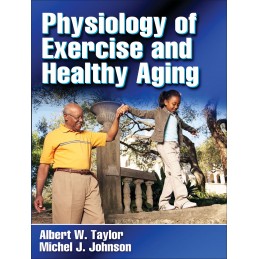- Obniżka


 Dostawa
Dostawa
Wybierz Paczkomat Inpost, Orlen Paczkę, DHL, DPD, Pocztę, email (dla ebooków). Kliknij po więcej
 Płatność
Płatność
Zapłać szybkim przelewem, kartą płatniczą lub za pobraniem. Kliknij po więcej szczegółów
 Zwroty
Zwroty
Jeżeli jesteś konsumentem możesz zwrócić towar w ciągu 14 dni*. Kliknij po więcej szczegółów
As life expectancy continues to increase, so does the need to understand the factors that increase health and vitality. Physiology of Exercise and Healthy Aging applies the science of exercise physiology to an analysis of the aging process and identifies the positive effects that regular exercise and physical activity have not only on longevity but also on delaying specific diseases, decreasing morbidity, and increasing quality of life. It presents theories on aging, the aging process, the structural and functional changes that characterize advancing age, exercise programming concerns for the aged, drug use and abuse by seniors, and the benefits of exercise and physical activity.
This text offers a more expansive discussion of the particulars of exercise physiology of aging persons than is found in other texts on the subject. With Physiology of Exercise and Healthy Aging, readers will gain a thorough understanding of the role of physical activity on the aging process, the principles of exercise and assessment considerations for elderly adults, and training for special needs of older adults. Information is presented in the context of three groups found in the aging and health spectrum:: average aging individuals, frail elderly, and master athletes. This information is organized within a three-part structure::
-Part I explores age-related changes in the major physiological systems. The effects of physical activity on these systems, as well as necessary adaptations for those with impaired abilities in each system, are also discussed.
-Part II deals with the interactive roles of nutrition; age-related diseases, such as diabetes and osteoporosis; and physical activity.
-Part III presents the physiologic adaptability that may be expected with training and physical activity of older adults. It also addresses the practical issues that must be considered when working with this population, including training for aerobic, anerobic, and muscular fitness; exercise adherence and safety measures; and potential substance abuse of commonly used medications.
In addition to the presentation of foundational concepts of physiology as they relate to the process of aging, chapters of Physiology of Exercise and Healthy Aging contain exercise regimens related to the chapter topic, other forms of physical activity that have proven beneficial to the aging population, and contraindicated exercises. Physiological responses to acute and chronic exercise perturbations are examined, including studies of cardiorespiratory fitness, muscle metabolism and strength, neurophysiology and the senses, and the effects of exercise on older adults with the diseases of aging, including type 2 diabetes, osteoporosis, arthritis, and cardiovascular disease. Chapter-opening quotes provide the insights of selected thinkers, scientists, and fitness professionals on the topic discussed.
Practitioners who work with older adults will find programming recommendations in each chapter to help translate the science into practice. An appendix offers easy access to forms and assessments, including a Three-Day Nutritional Assessment form and a Client History form. The language used throughout the text embraces the science of exercise physiology but also welcomes practitioners to apply the information presented.
For student readers, Physiology of Exercise and Healthy Aging incorporates these helpful features to assist learning and retention::
-Chapter-opening outlines offer quick reference to topics.
-Chapter-ending Questions to Consider provide tools for self-study and reflection.
-Numerous tables and figures reinforce chapter concepts and add visual or statistical information related to the process of aging, fall prevention, international demographics, and theories of aging.
-References provide additional opportunities for reading and research with selected books, articles, and Web sites.
-Appendixes contain information on specific Web sites and numerous tests and forms that may be photocopied for use with clients or patients or for course projects.
Physiology of Exercise and Healthy Aging contains a thorough discussion of the unique effects of aging on the human body and illustrates the power of exercise as a preventive tool to reduce or offset the deleterious effects of aging in order to increase the quality of life enjoyed by our aging population. With this text, both students and professionals will grasp the advantages of appropriate physical activity for the elderly and how to safely administer exercise programs that contribute to the increased health and quality of life for older adults.
Opis
Part I. Physiological Systems, Age-Related Changes, and the Role of Physical Activity
Introduction
Physical and Cognitive Changes With Aging
The Process of Aging
Aging and Homeostatic Processes
Aging Demographics
Theories of Aging
Physical Activity and Aging
Programming Recommendations
Review Elements
Chapter 1. Cardiopulmonary System
Structure and Function
Age-Related Changes
Cardiovascular Disease and Age
Programming Recommendations
Review Elements
Chapter 2. Musculoskeletal System
Muscle Morphology
Age-Related Changes in Biochemical Properties
Skeletal Muscle, Aging, and Training
Age-Related Diseases Limiting Exercise
Programming Recommendations
Review Elements
Chapter 3. Nervous System
Overview of the Nervous System
Age-Related Diseases
Programming Recommendations
Review Elements
Chapter 4. Sensory Systems
Hearing
Vision
Touch
Smell and Taste
Programming Recommendations
Review Elements
Part II. Nutrition, Common Diseases, and the Role of Physical Activity
Chapter 5. Nutrition and Diabetes
Nutrition for Older Adults
Benefits of Exercise and Healthy Eating
Diabetes
Programming Recommendations
Review Elements
Chapter 6. Bone Health and Osteoporosis
Bone Function and Structure
Osteoporosis
Nutrition for bone health
Physical Activity for Bone Health
Programming Recommendations
Review Elements
Part III. Physiologic Adaptability to Training and Physical Activity
Chapter 7. A Functional Approach to Exercise
Principles of Exercise
Exercise Prescription
Exercise Programming
Programming Recommendations
Review Elements
Chapter 8. Training for Aerobic and Anaerobic Fitness
Review of Exercise Physiology
Benefits of Aerobic and Anaerobic Fitness
Programming Recommendations
Review Elements
Chapter 9. Training for Muscular Fitness
Review of Exercise Physiology
Resistance Training Guidelines
The Challenge of Concurrent Training
Programming Recommendations
Review Elements
Chapter 10. Exercise Adherence and Safety Measures
Exercise Adherence
Safety
Programming Recommendations
Review Elements
Chapter 11. Older Athletes and Substance Abuse
Masters Athletes
Hormones
Anabolic Steroids
Analgesics and Anti-Inflammatories
Hypertension Medications
Other Medications
Dietary Supplementation and Ergogenics
Review Elements
